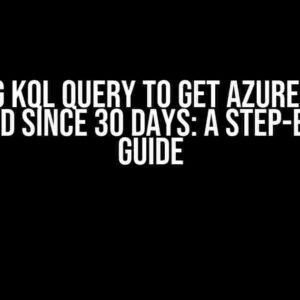Are you tired of tedious debugging processes and endless code scrolling? Do you want to take your development experience to the next level? Look no further! In this article, we’ll dive into the world of Microsoft’s Debug Adapter Protocol (DAP) and explore how to seamlessly integrate it with the Monaco Editor, a powerful and versatile code editor.
What is the Debug Adapter Protocol (DAP)?
The Debug Adapter Protocol (DAP) is an open-source protocol developed by Microsoft to provide a standardized way for debuggers and IDEs to communicate with each other. DAP enables language-agnostic debugging, allowing developers to debug their code in a unified manner, regardless of the programming language or platform.
Benefits of Using DAP
DAP offers numerous benefits, including:
- Unified debugging experience: DAP provides a consistent debugging experience across different languages and platforms.
- Faster debugging: DAP enables faster debugging by allowing debugging tools to communicate directly with the debug adapter.
- Improved code quality: DAP promotes better code quality by enabling developers to identify and fix issues more efficiently.
What is the Monaco Editor?
The Monaco Editor is a popular, open-source code editor developed by Microsoft. It’s known for its speed, flexibility, and extensibility. Monaco Editor provides a rich set of features, including syntax highlighting, code completion, and debugging capabilities.
Benefits of Using the Monaco Editor
The Monaco Editor offers several benefits, including:
- Lightning-fast performance: Monaco Editor is optimized for performance, providing a snappy and responsive coding experience.
- Customizable and extensible: Monaco Editor can be easily customized and extended using plugins and extensions.
- Seamless debugging integration: Monaco Editor provides built-in debugging capabilities, making it an ideal choice for developers.
Integrating DAP with the Monaco Editor: A Step-by-Step Guide
To integrate DAP with the Monaco Editor, follow these steps:
Step 1: Install the Monaco Editor
To start, you’ll need to install the Monaco Editor. You can download the editor from the official Monaco Editor website or use a package manager like npm or yarn.
npm install monaco-editorStep 2: Create a New Project
Create a new project folder and navigate to it in your terminal or command prompt.
mkdir dap-monaco-integration
cd dap-monaco-integrationStep 3: Install the Required Dependencies
Install the required dependencies, including the Monaco Editor and the DAP adapter.
npm install monaco-editor vscode-debugadapterStep 4: Create a New Monaco Editor Instance
Create a new Monaco Editor instance and configure it to use the DAP adapter.
import { editor } from 'monaco-editor';
import { DebugAdapter } from 'vscode-debugadapter';
const editorInstance = editor.create(document.getElementById('editor'), {
value: 'console.log("Hello, World!");',
language: 'javascript'
});
const debugAdapter = new DebugAdapter('node');
editorInstance.debug.setAdapter(debugAdapter);Step 5: Configure the DAP Adapter
Configure the DAP adapter to use the Monaco Editor instance.
debugAdapter.on('initialized', () => {
console.log('Debug adapter initialized!');
});
debugAdapter.on('terminated', () => {
console.log('Debug adapter terminated!');
});
debugAdapter.on('stopped', (event) => {
console.log(`Debug adapter stopped at ${event.threadId}=${event.frameId}`);
});
debugAdapter.on('continued', () => {
console.log('Debug adapter continued!');
});
editorInstance.debug.startDebugging(debugAdapter);Step 6: Create a Breakpoint
Create a breakpoint in your code using the Monaco Editor’s built-in debugging capabilities.
editorInstance.debug.breakpoints.setBreakpoints([
{
line: 1,
column: 1,
Verified: true
}
]);Step 7: Start Debugging
Start debugging your code using the Monaco Editor’s debugging capabilities.
editorInstance.debug.startDebugging(debugAdapter);Conclusion
Integrating the Debug Adapter Protocol (DAP) with the Monaco Editor is a straightforward process that can significantly improve your development experience. By following these steps, you can unlock the power of DAP and take advantage of its language-agnostic debugging capabilities. Say goodbye to tedious debugging processes and hello to faster, more efficient coding!
Troubleshooting Common Issues
If you encounter any issues during the integration process, refer to the following section for common troubleshooting tips:
| Error Message | Solution |
|---|---|
Cannot find module 'monaco-editor' |
Verify that you have installed the Monaco Editor correctly using npm or yarn. |
Debug adapter not initialized |
Check that you have properly configured the DAP adapter and initialized the Monaco Editor instance. |
Breakpoint not set |
Verify that you have created a breakpoint correctly using the Monaco Editor’s debugging capabilities. |
By following these steps and troubleshooting tips, you should be able to successfully integrate DAP with the Monaco Editor and enhance your debugging experience.
Future Development and Expansion
The integration of DAP with the Monaco Editor is just the beginning. As you explore the capabilities of DAP and the Monaco Editor, you can further customize and extend their functionality to suit your development needs. Some potential areas for future development and expansion include:
- Support for additional languages: Expand DAP support to include additional programming languages, such as Python, Java, or C++.
- Enhanced debugging features: Develop new debugging features, such as variable inspection, expression evaluation, or code stepping.
- Customizable debugging workflows: Create customized debugging workflows tailored to specific development scenarios or workflows.
The possibilities are endless, and the integration of DAP with the Monaco Editor provides a solid foundation for future innovation and growth.
Final Thoughts
In conclusion, integrating the Debug Adapter Protocol (DAP) with the Monaco Editor is a powerful way to enhance your development experience. By following these steps and troubleshooting tips, you can unlock the full potential of DAP and take advantage of its language-agnostic debugging capabilities. Happy coding!
Frequently Asked Question
Integrate Microsoft’s Debug Adapter Protocol (DAP) with the Monaco Editor and unlock a world of seamless debugging experiences. Here are some frequently asked questions to get you started:
What is the Debug Adapter Protocol (DAP), and why do I need it?
The Debug Adapter Protocol (DAP) is an open-source protocol developed by Microsoft that allows debuggers to communicate with debugging targets. By integrating DAP with the Monaco Editor, you can enable advanced debugging features like breakpoints, variable inspection, and stepping through code.
What are the prerequisites for integrating DAP with the Monaco Editor?
To integrate DAP with the Monaco Editor, you’ll need to have Node.js installed on your system, along with the Monaco Editor package. Additionally, you’ll need to set up a DAP-compatible debugger, such as the Visual Studio Code Debugger or the Chrome Debugger.
How do I set up a DAP server in the Monaco Editor?
To set up a DAP server in the Monaco Editor, you’ll need to create a new instance of the Monaco Editor and configure it to use the DAP protocol. This typically involves creating a new `DAPServer` instance and passing in the necessary configuration options, such as the debugger type and the path to the debugging target.
How do I connect the Monaco Editor to a DAP-compatible debugger?
To connect the Monaco Editor to a DAP-compatible debugger, you’ll need to create a new `DAPClient` instance and pass in the necessary configuration options, such as the debugger type and the path to the debugging target. Once connected, you can use the Monaco Editor to send debugging requests to the debugger and receive responses.
What are some advanced features I can enable with DAP and the Monaco Editor?
With DAP and the Monaco Editor, you can enable advanced features like conditional breakpoints, expression evaluation, and asynchronous debugging. You can also use DAP to support multiple debugging sessions simultaneously, making it easier to debug complex applications.




